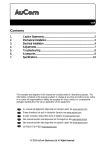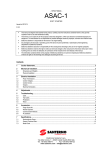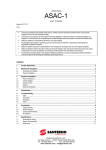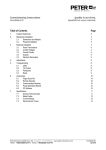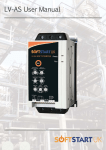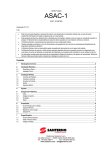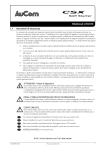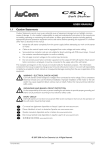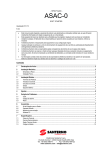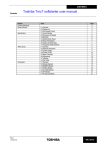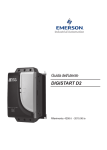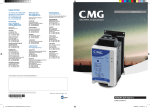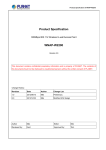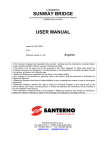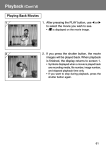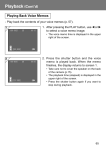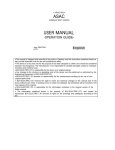Download ASAC-0 User Manual EN
Transcript
- 15P0071B200 - ASAC-0 SOFT STARTER Issued on 20/12/14 R. 02 This manual is integrant and essential to the product. Carefully read the instructions contained herein as they provide important hints for use and maintenance safety. This device is to be used only for the purposes it has been designed to. Other uses should be considered improper and dangerous. The manufacturer is not responsible for possible damages caused by improper, erroneous and irrational uses. Elettronica Santerno is responsible for the device in its original setting. Any changes to the structure or operating cycle of the device must be performed or authorized by the Engineering Department of Elettronica Santerno. Elettronica Santerno assumes no responsibility for the consequences resulting by the use of non-original spareparts. Elettronica Santerno reserves the right to make any technical changes to this manual and to the device without prior notice. If printing errors or similar are detected, the corrections will be included in the new releases of the manual. The information contained herein is the property of Elettronica Santerno and cannot be reproduced. Elettronica Santerno enforces its rights on the drawings and catalogues according to the law. Contents 1 Caution Statements.................................................................................................................................................... 2 2 Mechanical Installation .............................................................................................................................................. 2 2.1 2.2 3 3.1 3.2 3.3 3.4 3.5 Dimensions and Weights ..............................................................................................................................................................2 Physical Installation .......................................................................................................................................................................3 Electrical Installation ................................................................................................................................................. 3 Power Terminations ......................................................................................................................................................................3 Control Voltages ............................................................................................................................................................................3 Control Circuits ..............................................................................................................................................................................4 Outputs ..........................................................................................................................................................................................4 Electrical Schematics ....................................................................................................................................................................5 4 Adjustments................................................................................................................................................................ 6 5 Troubleshooting ......................................................................................................................................................... 7 5.1 5.2 5.3 6 6.1 6.2 6.3 6.4 7 7.1 7.2 7.3 7.4 LEDs..............................................................................................................................................................................................7 Trip Codes .....................................................................................................................................................................................7 Reset .............................................................................................................................................................................................7 Accessories ................................................................................................................................................................ 7 Finger Guard Kit ............................................................................................................................................................................7 Remote Operator...........................................................................................................................................................................7 Communication Modules ...............................................................................................................................................................8 PC Software ..................................................................................................................................................................................8 Specifications ............................................................................................................................................................. 8 Current Ratings .............................................................................................................................................................................8 Semiconductor Fuses ...................................................................................................................................................................9 General Technical Data ................................................................................................................................................................9 Model Code .................................................................................................................................................................................10 Elettronica Santerno S.p.A. Via della Concia 7, 40023 Castel Guelfo (BO) Italy Tel. +39 0542 489711 – Fax +39 0542 489722 www.santerno.com [email protected] 1 Caution Statements Caution Statements cannot cover every potential cause of equipment damage but can highlight common causes of damage. It is the installer's responsibility to read and understand all instructions in this manual prior to installing, operating or maintaining the equipment, to follow good electrical practice including applying appropriate personal protective equipment and to seek advice before operating this equipment in a manner other than as described in this manual. Isolate the ASAC-0 completely from the power supply before attempting any work on the ASAC-0 or motor. Cables to the control inputs must be segregated from mains voltage and motor cabling. Some electronic contactor coils are not suitable for direct switching with PCB mount relays. Consult the contactor manufacturer/supplier to confirm suitability. Do not apply incorrect voltages to the control input terminals. Do not connect power factor correction capacitors to the output of ASAC-0 soft starters. If static power factor correction is employed, it must be connected to the supply side of the soft starter. The examples and diagrams in this manual are included solely for illustrative purposes. The information contained in this manual is subject to change at any time and without prior notice. In no event will responsibility or liability be accepted for direct, indirect or consequential damages resulting from the use or application of this equipment. WARNING - ELECTRICAL SHOCK HAZARD The ASAC-0 contains dangerous voltages when connected to mains voltage. Only a qualified electrician should carry out the electrical installation. Improper installation of the motor or the ASAC-0 may cause equipment failure, serious injury or death. Follow this manual and local electrical safety codes. GROUNDING AND BRANCH CIRCUIT PROTECTION It is the responsibility of the user or person installing the ASAC-0 to provide proper grounding and branch circuit protection according to local electrical safety codes. SHORT CIRCUIT The ASAC-0 is not short circuit proof. After severe overload or short circuit, the operation of the ASAC-0 should be fully tested by an authorised service agent. 2 Mechanical Installation 2.1 Dimensions and Weights F A B H D H 15756.C G E C Height mm (inch) Model ASAC-0//007 ASAC-0//015 ASAC-0//018 ASAC-0//022 ASAC-0//030 ASAC-0//037 ASAC-0//045 ASAC-0//055 ASAC-0//075 ASAC-0//090 ASAC-0//110 2/10 Width mm (inch) Depth mm (inch) mm (inch) mm (inch) mm (inch) E F G H Weight kg (lb) A B C D 201 (7.91) 188 (7.40) 98 (3.85) 82 (3.22) 165 (6.49) 55 (2.16) 90.5 (3.6) 23 (0.9) 2.1 (4.6) 215 (8.46) 196 (7.71) 145 (5.70) 124 (4.88) 193 (7.59) - 110.5 (4.4) 37 (1.5) 3.8 (8.4) 240 (9.44) 216 (8.50) 200 (7.87) 160 (6.29) 214 (8.42) - 114.5 (4.5) 51 (2.0) 6.1 (13.5) ASAC-0 2.2 Physical Installation 1 2 15757.A 4 3 ASAC-0/007 ~ ASAC-0/055: Allow 100 mm (3.9 inch) between soft starters. ASAC-0/075 ~ ASAC-0/110: Allow 200 mm (7.9 inch) between soft starters. ASAC-0/007 ~ ASAC-0/055: Allow 50 mm (2.0 inch) between the soft starter and solid surfaces. ASAC-0/075 ~ ASAC-0/110: Allow 200 mm (7.9 inch) between the soft starter and solid surfaces. Soft starters may be mounted side by side with no clearance (that is, if mounted without communications modules). The soft starter may be mounted on its side. Derate the soft starter's rated current by 15%. Electrical Installation 3.1 Power Terminations L1/1, L2/3, L3/5, T1/2, T2/4, T3/6 mm2 (AWG) 14 mm (0.55 inch) Torx (T20) 3 Nm 2.2 ft-lb 7 mm 3 Nm 2.2 ft-lb 3.2 N.A. 14 mm (0.55 inch) Torx (T20) 4 Nm 2.9 ft-lb 7 mm 4 Nm 2.9 ft-lb 11 (0.43) 26 Ø 8.5 (1.02)(0.33) 10429.A 25 - 50 (4 - 1/10) 075 - 110 10428.A 10 - 35 (8 - 2) 037 - 055 10428.A 10427.A 007 - 030 A1, A2, A3, 01, 02, 13, 14, 23, 24 mm2 (AWG) 007 - 110 0.14 - 1.5 (26 - 16) mm (inch) 10428.A 3 6 mm (0.24 inch) N.A. N.A. N.A. 3.5 mm 0.5 Nm max 4.4 in-lb max Control Voltages ASAC-0 soft starters can be supplied in either of two control voltage configurations: ASAC-0/xxxxx1 ..... 110-240 VAC (+ 10% / - 15%) or 380-440 VAC (+ 10% / - 15%) ASAC-0/xxxxx2 ..... 24 VAC/VDC (± 20%) WARNING Always apply control voltage before (or with) mains voltage. CAUTION With 24 VAC/VDC use contacts rated for low voltage and low current (gold flash or similar). ASAC-0 3/10 3.3 Control Circuits Two-wire Three-wire Start/stop. To reset a trip, open then close 02. Start. Stop. To reset a trip, open then close 02. WARNING Isolate the ASAC-0 completely from the power supply before attempting any work on the ASAC-0 or motor. Control terminals may be at phase voltage potential. CAUTION For ASAC-0/xxx/x/2 (24VAC/VDC control voltage) units you can connect an external 24 VDC supply into the control input terminals 01, 02. 3.4 Outputs 3.4.1 Main Contactor Output The Main Contactor output (terminals 13, 14) closes as soon as the soft starter receives a start command and remains closed while the soft starter is controlling the motor (until the motor starts a coast to stop, or until the end of a soft stop). The Main Contactor output will also open if the soft starter trips. The Main Contactor output can be used to directly control a main contactor coil. 3.4.2 Run Output The run output relay (terminals 23, 24) can be used to signal run status. This relay is normally open. The relay operates when the soft start is complete, the bypass relays are closed and full voltage is being applied to the motor. The relay can be used to operate a contactor for power factor correction capacitors, or to signal soft starter run status to an automation system. 4/10 ASAC-0 Electrical Schematics Soft starter installed with a motor protection circuit breaker M K1 13, 14 23, 24 1/L1 2/T1 3/L2 4/T2 5/L3 6/T3 Soft starter installed with a motor protection circuit breaker and main contactor K1 M 1/L1 2/T1 3/L2 4/T2 5/L3 6/T3 13 14 13 14 23 24 23 24 03238.D 3.5 M K1 Motor (three phase) Main contactor Main contactor output Run contactor output ASAC-0 5/10 4 Adjustments Initial Start Voltage Start Ramp Time 1 Stop Ramp Time 15098.A 3 Initial Start Voltage Select the initial start voltage (A). Application Centrifugal Pump Submersible Pump Screw Compressor Conveyor Crusher Fan Other applications Initial Start Voltage Suggested setting 50% 60% 70% Start Ramp Time Select the start ramp time (B). The start ramp defines how long the soft starter will take to increase voltage from the initial start voltage to full voltage. The start ramp time does not control the time the motor will take to reach full speed. 1. Set the start ramp time to 20 seconds. 2. Set the initial start voltage as required for the application. 3. Attach a current monitoring device to output T1. 4. Start the motor under normal load conditions. Record the time required for the measured current to fall to (or below) the motor's rated full load current (t1) then stop the motor. 5. Set start ramp time = t1. NOTE The start ramp time must be long enough for the motor to reach full speed before the soft starter enters bypass mode. Stop Ramp Time Select the soft stop ramp time (C). Soft stop extends the time soft starter takes to reduce voltage to zero. The ramp time does not control the time the motor will take to stop completely. 6/10 ASAC-0 5 Troubleshooting 5.1 LEDs LED Status Off On Flash Ready Reset Run Ready Run No control power Ready Starter tripped Motor not running Motor running at full speed Motor starting or stopping Ready Run 15099.A 4 5.2 Trip Codes The Ready LED will flash a different number of times to indicate the cause of the trip. Ready LED Description Power Circuit: Check mains supply (L1, L2, L3), motor circuit (T1, T2, T3), soft starter SCRs and bypass relays. x1 Supply Frequency: Check mains voltage is available and supply frequency is in range. x6 Network Communication Failure (between module and network): Check network connections, settings and x8 configuration. Starter Communication Failure (between starter and module): Remove and refit accessory module. x9 5.2.1 Supply Frequency Protection The soft starter will trip on supply frequency if the frequency rises above 72 Hz or falls below 40 Hz for more than five seconds while the soft starter is running. These trip points are not adjustable. In pre-start, starting and stopping modes the high and low frequency limits both apply with no time delay. A supply frequency trip will also occur if: all three input phases are lost while the soft starter is running all three input phases fall below 120 VAC at start or while the soft starter is running the line contactor opens while running 5.3 Reset Trips can be cleared by pressing the Reset button on the soft starter, sending a Reset command from the serial communications network, or by switching the control inputs. To clear a trip via the control inputs, the soft starter requires a closed to open transition on the stop input (02). In three-wire control, use the external stop button to momentarily open the stop input (open A1-02). In two-wire control, if the soft starter tripped with a start signal present, remove the start signal (open A1 to 01, 02). The Reset button is located on the front of the unit, above the adjustment switches. The soft starter will trip again immediately if the cause of the trip still exists. 6 Accessories 6.1 Finger Guard Kit Finger guards may be specified for personnel safety. Finger guards fit over the soft starter terminals to prevent accidental contact with live terminals. Finger guards provide IP20 protection when used with cable of diameter 22 mm or greater. 6.2 Remote Operator The Remote Operator can control and monitor the soft starter's performance. Functionality includes: Operational control (Start, Stop, Reset, Quick Stop) Starter status monitoring (Ready, Starting, Running, Stopping, Tripped) Trip code display ASAC-0 7/10 6.3 Communication Modules ASAC-0 soft starters support network communication via easy-to-install communications modules. Each soft starter can support one communications module at a time. Available protocols: Ethernet (Profinet, Modbus TCP, Ethernet/IP), Profibus, DeviceNet, Modbus RTU, and USB. NOTE Ethernet communication modules are not suitable for use with ASAC starters using 380/440 V AC control voltage. 6.4 PC Software WinMaster can be used with Santerno soft starters to provide the following functionality for networks of up to 99 soft starters: Operational control (Start, Stop, Reset, Quick Stop) Starter status monitoring (Ready, Starting, Running, Stopping, Tripped) To use WinMaster with the ASAC-0, the soft starter must be fitted with a USB Module, Modbus Module or a Remote Operator. 7 Specifications 7.1 Current Ratings ASAC-0/007 ASAC-0/015 ASAC-0/018 ASAC-0/022 ASAC-0/030 ASAC-0/037 ASAC-0/045 ASAC-0/055 ASAC-0/075 ASAC-0/090 ASAC-0/110 8/10 AC53b 4-6:354 < 1000 metres 40 °C 50 °C 18 A 17 A 34 A 32 A 42 A 40 A 48 A 44 A 60 A 55 A AC53b 4-6:594 < 1000 metres 40 °C 50 °C 75 A 68 A 85 A 78 A 100 A 100 A 140 A 133 A 170 A 157 A 200 A 186 A ASAC-0 AC53b 4-20:340 < 1000 metres 40 °C 50 °C 17 A 15 A 30 A 28 A 36 A 33 A 40 A 36 A 49 A 45 A AC53b 4-20 580 < 1000 metres 40 °C 50 °C 65 A 59 A 73 A 67 A 96 A 87 A 120 A 110 A 142 A 130 A 165 A 152 A 7.2 Semiconductor Fuses Semiconductor fuses can be used with ASAC-0 soft starters to reduce the potential for damage to SCRs from transient overload currents and for Type 2 coordination. ASAC-0 soft starters have been tested to achieve Type 2 coordination with semiconductor fuses. Suitable Bussmann and Ferraz/Mersen semiconductor fuses are detailed below. Model SCR I2t (A2s) ASAC-0/007 1150 ASAC-0/015 8000 ASAC-0/018 10500 ASAC-0/022 15000 ASAC-0/030 18000 ASAC-0/037 51200 ASAC-0/045 80000 ASAC-0/055 97000 ASAC-0/075 168000 ASAC-0/090 245000 ASAC-0/110 320000 Ferraz/Mersen Fuse European/IEC Style (North American Style) 6.6URD30xxxA0063 (A070URD30xxx0063) 6.6URD30xxxA0125 (A070URD30xxx0125) 6.6URD30xxxA0160 (A070URD30xxx0160) 6.6URD30xxxA0160 (A070URD30xxx0160) 6.6URD30xxxA0160 (A070URD30xxx0160) 6.6URD30xxxA0250 (A070URD30xxx0250) 6.6URD30xxxA0315 (A070URD30xxx0315) 6.6URD30xxxA0315 (A070URD30xxx0315) 6.6URD31xxxA0450 (A070URD31xxx0450) 6.6URD31xxxA0450 (A070URD31xxx0450) 6.6URD31xxxA0450 (A070URD31xxx0450) Bussmann Fuse Square Body (170M) Bussmann Fuse British Style (BS88) 170M-1314 63 FE 170M-1317 160 FEE 170M-1318 160 FEE 170M-1318 180 FM 170M-1319 180 FM 170M-1321 250 FM 170M-1321 250 FM 170M-1321 250 FM 170M-1322 500 FMM 170M-3022 500 FMM 170M-3022 500 FMM xxx = Blade Type. Contact Ferraz/Mersen for options. 7.3 General Technical Data Mains Supply Mains voltage (L1, L2, L3) 4 ........................................................................................................................................... 3 x 200 VAC ~ 440 VAC (+ 10% / - 15%) 5 ........................................................................................................................................... 3 x 200 VAC ~ 575 VAC (+ 10% / - 15%) Mains frequency (at start) ..................................................................................................................................................... 45 Hz to 66 Hz Rated insulation voltage ................................................................................................................................................................. 600 VAC Form designation .................................................................................................................. Bypassed semiconductor motor starter form 1 Control Voltage (A1, A2, A3) ASAC-0/xxx/x/1 ............................................................................................................................................. 110-240 VAC (+ 10% / - 15%) ........................................................................................................................................................... or 380-440 VAC (+ 10% / - 15%) ASAC-0/xxx/x/2 .......................................................................................................................................................... 24 VAC/VDC (± 20%) Current consumption (during run) ................................................................................................................................................. < 100 mA Current consumption (inrush) ASAC-0/xxx/x/1 .............................................................................................................................................................................. 10 A ASAC-0/xxx/x/2 ................................................................................................................................................................................ 2 A Inputs Start (terminal 01) ................................................................................................................................................................... Normally open ................................................................................................................................ 150 k @ 300 VAC and 5.6 k @ 24 VAC/VDC Stop (terminal 02) ................................................................................................................................................................ Normally closed ................................................................................................................................ 150 k @ 300 VAC and 5.6 k @ 24 VAC/VDC Outputs Main contactor (terminals 13, 14) ........................................................................................................................................... Normally open .................................................................................................................................................... 6 A, 30 VDC / 6 A, 250 VAC resistive Run relay (terminals 23, 24) ................................................................................................................................................... Normally open .................................................................................................................................................... 6 A, 30 VDC / 6 A, 250 VAC resistive Environmental Degree of Protection ASAC-0/007 to ASAC-0/055 ............................................................................................................................... IP20 Degree of Protection ASAC-0/075 to ASAC-0/110 ............................................................................................................................... IP00 Operating temperature ..................................................................................................................................................... - 10 °C to + 60 °C Storage temperature .................................................................................................. -25 °C to + 60 °C (to +70 °C for less than 24 hours) ASAC-0 9/10 Humidity ......................................................................................................................................................... 5% to 95% Relative Humidity Pollution degree .............................................................................................................................................................. Pollution Degree 3 Vibration ........................................................................................................................................................ IEC 60068 Test Fc Sinusoidal ................................................................................................................................................. 4 Hz to 13.2 Hz: ± 1 mm displacement .................................................................................................................................................................... 13.2 Hz to 200 Hz: ± 0.7 g EMC Emission Equipment class (EMC) ................................................................................................................................................................. Class B Conducted radio frequency emission ............................................................................................ 0.15 MHz to 0.5 MHz: < 56-46 dB (µV) ......................................................................................................................................................... 0.5 MHz to 5 MHz: < 46 dB (µV) .............................................................................................................................................................. 5 MHz to 30 MHz: 50 dB (µV) Radiated radio frequency emission .................................................................................................... 30 MHz to 230 MHz: < 30 dB (µV/m) ................................................................................................................................................ 230 MHz to 1000 MHz: < 37 dB (µV/m) EMC Immunity Electrostatic discharge .............................................................................................................. 4 kV contact discharge, 8 kV air discharge Radio frequency electromagnetic field ............................................................................................... 0.15 MHz to 1000 MHz: 140 dB (µV) Rated impulse withstand voltage (Fast transients 5/50 ns) .................................................................... 2 kV line to earth, 1 kV line to line Voltage dip and short time interruption .................................................................................................... 100 ms (at 40% nominal voltage) Harmonics and distortion .............................................................................................................. IEC61000-2-4 (Class 3), EN/IEC61800-3 .......................................................................................................................................................................... EAC TP TC 020/2011 Short Circuit Rated short-circuit current ASAC-0/007 to ASAC-0/022 ...................................................................................................................... 5 kA1 Rated short-circuit current ASAC-0/030 to ASAC-0/110 .................................................................................................................... 10 kA1 1 These short circuit ratings are with fuses used as given in the table under Semiconductor Fuses on page 9. Heat Dissipation During Start ........................................................................................................................................................................ 3 watts / ampere During Run ........................................................................................................................................................................... 10 watts typical Approvals C ....................................................................................................................................................................................... IEC 60947-4-2 CE ....................................................................................................................................................................................... IEC 60947-4-2 EAC (formerly GOST) ....................................................................................................................................................... TP TC 004/2011 RoHS ............................................................................................................................................ Compliant with EU Directive 2002/95/EC UL / C-UL .......................................................................................................................................................................................... UL 508 Operational Life ASAC-0/007~055 ........................................................................................................................................................ 1,000,000 operations ASAC-0/075~110 ............................................................................................................................................................. 30,000 operations 7.4 Model Code ASAC-0/ / / Control voltage 1 = 110-240 VAC & 380-440 VAC 2 = 24 VAC/VDC Mains voltage 4 = 200 ~ 440 VAC 5 = 200 ~ 575 VAC Nominal kW rating @400 VAC 007~030: AC53b 4-6-354 037~110: AC53b 4-6-594 10/10 ASAC-0










